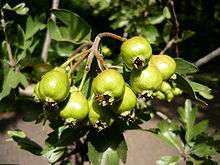Crataegus azarolus
| Crataegus azarolus | |
|---|---|
 | |
| Scientific classification | |
| Kingdom: | Plantae |
| (unranked): | Angiosperms |
| (unranked): | Eudicots |
| (unranked): | Rosids |
| Order: | Rosales |
| Family: | Rosaceae |
| Genus: | Crataegus |
| Series: | Orientales Pojark.[1] |
| Species: | C. azarolus |
| Binomial name | |
| Crataegus azarolus L. | |
| Synonyms | |

Crataegus azarolus is a species of hawthorn known by the common names azarole, azerole, and Mediterranean medlar. It is native to the Mediterranean Basin and is a common plant there, growing on sites comparable to those the European common hawthorn grows on. In the Arabic-speaking countries it is the commonest of the hawthorn species; in the Arabic language the term "common hawthorn" means the azarole hawthorn. When growing in the wild the azerole bears plentiful crops of haw fruits, which are similar to the haws of the European common hawthorn, but plumper.
C. azarolus is often divided into subspecies or varieties, for example Christensen in his monograph[1] uses four varieties:
- C. azarolus var. azarolus has orange fruit.
- C. azarolus var. aronia L., has yellowish fruit often with some red tinges
- C. azarolus var. chlorocarpa (Moris) K.I.Chr. has yellowish fruit
- C. azarolus var. pontica (K.Koch) K.I.Chr. has yellowish or orange fruit
C. azarolus has been used historically for a number of medicinal purposes.[3]

See also
References
| Wikimedia Commons has media related to Crataegus azarolus. |
- 1 2 Christensen, K.I. (1992) Revision of Crataegus sect. Crataegus and nothosect. Crataeguineae (Rosaceae-Maloideae) in the Old World. The American Society of Plant Taxonomists, Ann Arbor, Michigan, U.S.A.
- ↑ Plants for a Future PFAF (page 1)
- ↑ Ljubuncic, P., et al. (2005). Antioxidant activity of Crataegus aronia aqueous extract used in traditional Arab medicine in Israel. Journal of Ethnopharmacology 101:1 153-61.
External links
Further reading
- Hadjimitsi, E.; I. Zabetakis (2005), "The aroma of jam prepared from fruits of mosphilla (Crataegus azarolus)", Flavour and Fragrance Journal, 20 (5): 507–511, doi:10.1002/ffj.1476
- Phipps, James B., Robert J. O’Kennon and Ron W. Lance (2003), Hawthorns and medlars, Cambridge, U.K.: Royal Horticultural Society. and Portland, Oregon: Timber Press